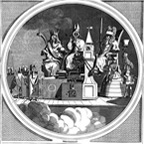The constituent power is a puzzle for constitutional theory. Where does the authority to enact a constitution come from if it is the constitution that establishes the authority? Today it is generally accepted that the constituent power lies with the people. But does this answer the question? The people are not capable of collective decision-making before they have been constituted as a political entity. After having been constituted they are no longer acting as constituent power but as constituted power, which means: within the boundaries and according to the rules prescribed by the constitution.
No satisfactory solution of this puzzle has yet been found. Most theories help themselves by assuming that constitution-making is not conceivable in legal terms, Carré de Malberg being a prominent voice of this concept. Rather it is regarded as a matter of fact or more precisely a matter of power. Those who de facto hold the power go ahead and draft and enact a constitution and claim to do so in the name of the people. Whether this claim is justified can only be ascertained in retrospect. Not the act of adopting a constitution is decisive but what follows. The constituent power is thus dissolved in a process.
Carl Schmitt takes a different approach. He does not escape the problem but tries to solve it by assuming that the legal constitution is preceded by an essential decision of a group of persons who understand themselves as a people. This decision determines the nature and form of the political unity. It is constitutive of a political entity although it is not an organized act and does not find expression in a text. What is usually understood as constitution, namely the document, is derived from the essential decision that it merely concretizes and makes operational. Here the constituent power is reduced to a decision.
If we leave the theoretical puzzle aside and instead turn to the historical emergence of constitutions the question arises: How are the people involved? One possibility is that they elect a constituent assembly which then drafts and enacts a constitution. However, this presupposes some power that orders the election to be held, defines the terms and organizes the procedure. This power is itself not legally authorized to do so. It empowers itself. Another possibility is that the factual power holders themselves draft a constitution and submit the draft to a referendum. The people may then adopt or reject it. But again they are not legally authorized to do so. […]
Scarica il testo in formato PDF
Table of contents: 1. The constituent power. ― 2. The amendment power. ― 3. The limits of amendments. ― 4. Unconstitutional constitutional amendments. ― 5. The amendability of the amendment clause.






